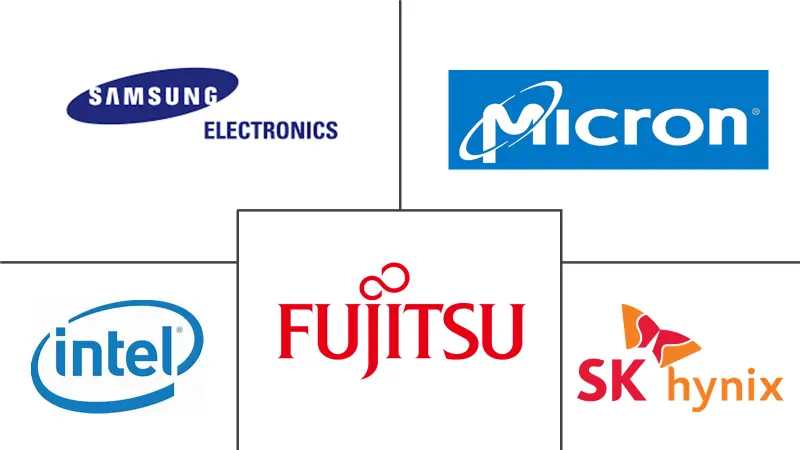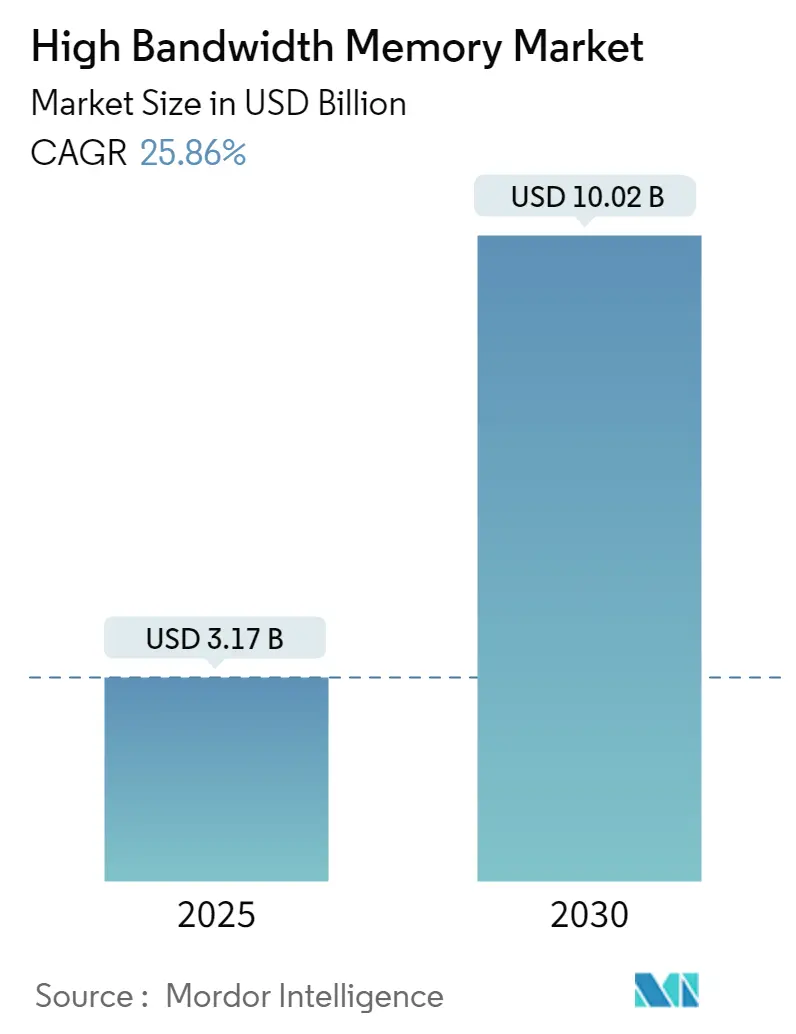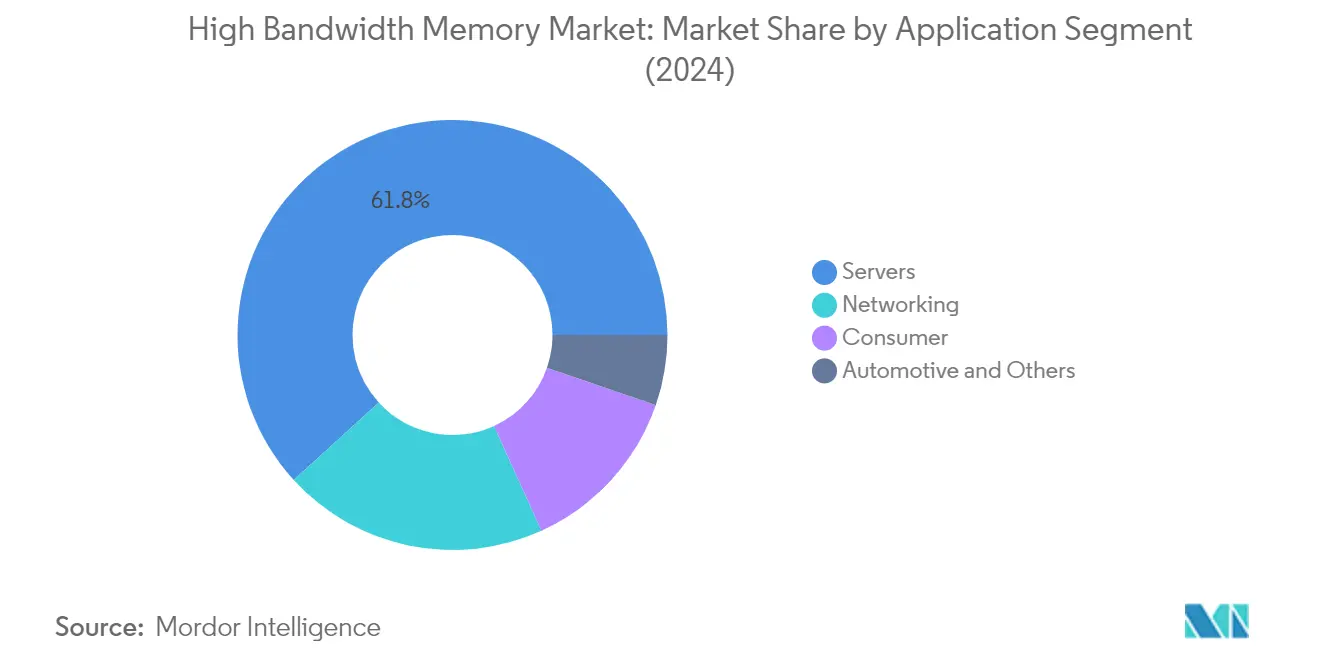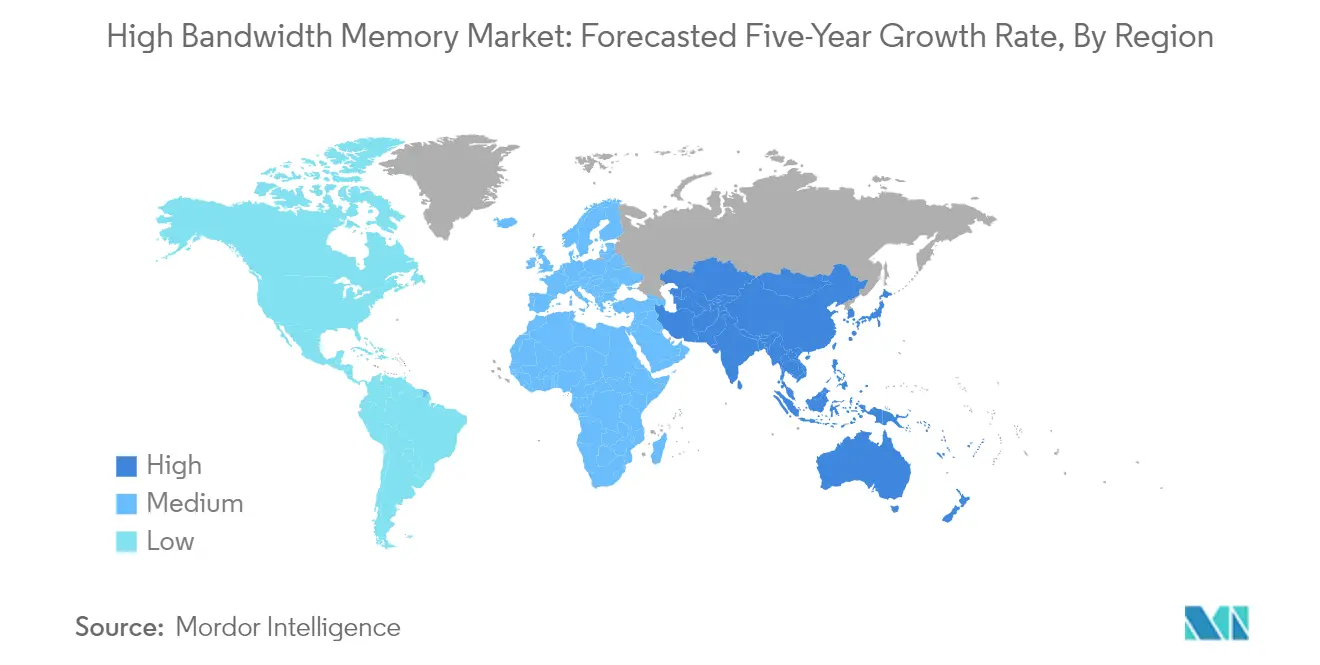High Bandwidth Memory Market Analysis
The High Bandwidth Memory Market size is estimated at USD 3.17 billion in 2025, and is expected to reach USD 10.02 billion by 2030, at a CAGR of 25.86% during the forecast period (2025-2030).
The high bandwidth memory industry is experiencing transformative changes driven by the rapid evolution of computing infrastructure and data processing requirements. The emergence of next-generation computing architectures has necessitated more sophisticated memory solutions, with HBM technology becoming increasingly central to addressing these demands. The industry has witnessed significant technological advancements, particularly in the development of HBM3 technology, which has achieved unprecedented data processing capabilities. For instance, SK Hynix's latest HBM3 technology can process up to 819 gigabytes per second, enabling the transmission of 163 full-HD movies in a single second, representing a remarkable 78% increase in HBM data rate compared to previous generations.
The expansion of data center infrastructure continues to be a major catalyst for HBM adoption. According to Cloudscene's 2021 data, the United States leads with 2,670 data centers, followed by the United Kingdom with 452 and Germany with 443, highlighting the massive scale of data processing infrastructure requiring high bandwidth memory solutions. This proliferation of data centers has created a substantial demand for memory solutions that can handle increasingly complex workloads while maintaining energy efficiency. The industry has responded with innovations in memory architecture and integration techniques, particularly in the development of 2.5D and 3D stacking technologies.
The market is witnessing a significant shift toward integrated solutions that combine memory and processing capabilities. Samsung's introduction of HBM-PIM (Processing-In-Memory) technology represents a breakthrough in this direction, integrating artificial intelligence processing capabilities directly into HBM memory chips. This innovation marks a fundamental change in memory architecture, enabling systems to perform computational tasks directly within the memory subsystem, thereby reducing data movement and improving overall system efficiency. The technology demonstrates the industry's move toward more sophisticated, integrated memory solutions that can address the growing demands of modern computing applications.
The supercomputing sector has emerged as a crucial driver of HBM technology advancement, with major players investing heavily in developing solutions for high-performance computing applications. Intel's announcement of Sapphire Rapids processors with integrated HBM support represents a significant development in mainstream server processors, indicating the technology's growing importance in enterprise computing. This trend is further supported by the increasing number of supercomputing installations globally, with TOP500 data showing a growth in the number of supercomputers in the United States from 113 to 122 by June 2021, highlighting the expanding infrastructure requiring high bandwidth memory solutions.
High Bandwidth Memory Market Trends
Growing Need for High-Bandwidth, Low Power Consuming, and Highly Scalable Memories
The exponential growth in data creation and processing requirements has intensified the demand for high-bandwidth memory and power-efficient memory solutions across industries. According to industry data, the amount of data created, captured, copied, and consumed increased from 2 zettabytes in 2010 to 64.2 ZB in 2020, with projections reaching 181 ZB by 2025. This massive surge in data processing needs has pushed organizations to pursue significant improvements across data infrastructure, computing capabilities, and memory bandwidth optimization. The increasing number of connected devices, expected to reach 500 billion by 2030, further amplifies the need for efficient memory solutions that can handle extensive data processing while maintaining low power consumption.
The evolution of memory bandwidth requirements is evident in the progression of HBM technology generations. The transition from HBM2 to HBM2E demonstrated significant improvements, with HBM2E achieving data rates of around 3.6 Gbps and 460 GB/s bandwidth, compared to HBM2's 2 Gbps and 256 GB/s. This advancement in HBM memory technology directly addresses the growing demands of data centers and cloud service providers, who require higher bandwidth capabilities to support increasingly complex workloads. The integration of high-bandwidth memory solutions has become crucial for organizations seeking to balance performance optimization with power efficiency, particularly in applications requiring real-time data processing and analysis.
Increasing Adoption of Artificial Intelligence
The proliferation of artificial intelligence across enterprises has created unprecedented demands for memory bandwidth and processing capabilities. According to recent industry surveys, nearly 34% of organizations are actively implementing AI solutions, while 27% have developed but not yet implemented AI systems, indicating a strong trajectory for AI adoption across industries. The integration of AI in various applications, from data analytics to autonomous systems, requires memory solutions capable of handling complex neural networks containing upward of 100 billion parameters and processing enormous amounts of training data efficiently.
The automotive sector exemplifies the growing integration of AI and its impact on memory requirements, particularly in advanced driver-assistance systems (ADAS) and autonomous driving applications. These systems require memory bandwidths exceeding 200 GB/s to support complex AI/ML algorithms needed for real-time decision-making on the road. The development of AI-enabled memory solutions, such as HBM-PIM (Processing-In-Memory) technology, demonstrates the industry's response to these demands, offering accelerated compute performance while reducing power consumption. These innovations enable AI applications to process larger datasets more efficiently, supporting the growing complexity of AI workloads across various sectors.
Rising Trend of Miniaturization of Electronic Devices
The continuous push toward smaller, lighter, and higher-performing electronics has made miniaturization a crucial driver in the HBM semiconductor market. The vertical stacking technology used in HBM, combined with 2.5D interposer technology, enables memory chips to achieve smaller form factors without compromising performance attributes. This advancement is particularly significant in automotive applications, where space constraints and the need for improved electrical performance must be balanced. The integration of multiple electronic systems in modern vehicles, especially in ADAS and autonomous driving systems, demands memory solutions that can deliver high bandwidth while maintaining compact dimensions.
The impact of miniaturization extends beyond automotive applications into consumer electronics and data center infrastructure. The trend toward more condensed form factors has led to innovations in memory packaging technology, such as the development of hybrid bonding and 16-die stacks with low profiles. These advancements enable the integration of more powerful computing capabilities in smaller spaces, addressing the growing demand for compact yet high-performance electronic devices. The industry's focus on research and development in areas such as 3DS technology and four DRAM die stacks demonstrates the ongoing commitment to pushing the boundaries of miniaturization while maintaining or improving performance capabilities.
Segment Analysis: By Application
Servers Segment in High Bandwidth Memory Market
The servers segment continues to dominate the high bandwidth memory market, commanding approximately 62% of the total market share in 2024. This significant market position is primarily driven by the explosive growth in data center deployments and the increasing adoption of high-performance computing applications. The segment's growth is further bolstered by the rising demand for low-latency HBM solutions in server applications, particularly in addressing the common challenge of the memory wall—where increased power consumption and latency issues occur during data movement between the processor and DRAM. Major hyperscale data centers are increasingly integrating HBM memory solutions to overcome bandwidth bottlenecks and improve overall system performance. The placement of discrete chips on server boards has also influenced the adoption of HBM, as it helps in optimizing available space while reducing energy consumption through closer placement of memory components.
Consumer Segment in High Bandwidth Memory Market
The consumer segment is emerging as the fastest-growing segment in the high bandwidth memory market, projected to grow at approximately 27% during the forecast period 2024-2029. This remarkable growth is primarily driven by the increasing integration of advanced technologies like artificial intelligence and machine learning in consumer electronics. The segment is witnessing substantial innovation in graphics processing capabilities, particularly in gaming applications where high-bandwidth memory solutions are becoming increasingly critical. The evolution of consumer video cards and graphics processing units (GPUs) is creating a strong demand for HBM technology, with major manufacturers focusing on enhancing graphics card capabilities through HBM integration. The segment's growth is further accelerated by the rising demand for high-performance computing in consumer applications, particularly in areas such as virtual reality, augmented reality, and advanced gaming systems.
Remaining Segments in High Bandwidth Memory Market
The networking and automotive segments represent significant opportunities in the memory market. The networking segment addresses the challenges of high-density and high-bandwidth requirements through 3D stacked memory technology, which is particularly beneficial for next-generation networking applications and data centers. The automotive segment is gaining traction with the increasing integration of advanced driver-assistance systems (ADAS) and autonomous driving technologies, which require high-performance memory solutions for real-time data processing. Both segments are witnessing technological advancements in terms of improved bandwidth capabilities, reduced power consumption, and smaller form factors, making them crucial components of the overall market landscape.
High Bandwidth Memory Market Geography Segment Analysis
High Bandwidth Memory Market in North America
North America continues to maintain its dominant position in the global high bandwidth memory market, holding approximately 44% of the HBM market share in 2024. This leadership position is primarily driven by the region's robust high-performance computing (HPC) applications sector that demands high-bandwidth memory solutions for rapid data processing. The region's strong market position is reinforced by the presence of major technology companies and their substantial investments in artificial intelligence, machine learning, and cloud computing infrastructure. The high adoption of HBM in North America is further supported by the region's advanced semiconductor ecosystem and the presence of leading chip manufacturers. The market is particularly strong in data center applications, where the demand for high-speed, low-latency memory solutions continues to grow. The region's focus on technological innovation, coupled with substantial research and development investments, has created a favorable environment for HBM adoption. Additionally, the increasing deployment of AI-driven applications across various industries has created a sustained demand for high-performance memory solutions, further strengthening North America's position in the global HBM market.
High Bandwidth Memory Market in Japan
Japan's high bandwidth memory market has demonstrated remarkable growth, achieving approximately a 22% compound annual growth rate from 2019 to 2024. The country's market expansion is driven by its strong foundation in semiconductor manufacturing and continuous technological innovations in memory solutions. Japan's market growth is characterized by its focus on developing advanced memory technologies for various applications, particularly in the automotive and consumer electronics sectors. The country's robust research and development infrastructure, combined with strong government support for technological advancement, has created a conducive environment for HBM market growth. Japanese HBM manufacturers have been particularly successful in developing specialized HBM solutions for specific industry applications, leveraging their expertise in semiconductor manufacturing. The market has also benefited from the country's strong emphasis on quality and reliability in memory solutions, making Japanese HBM products highly sought after in global markets. Furthermore, Japan's strategic position in the global semiconductor supply chain has helped maintain its competitive edge in the HBM market.
High Bandwidth Memory Market in China
China's high bandwidth memory market is poised for exceptional growth, with projections indicating a robust growth rate of approximately 28% annually from 2024 to 2029. The country's aggressive push towards technological self-sufficiency and substantial investments in semiconductor manufacturing capabilities are driving this growth trajectory. China's market expansion is supported by its rapidly growing artificial intelligence and data center sectors, which create substantial HBM demand for high-performance memory solutions. The country's strategic focus on developing its domestic semiconductor industry, coupled with significant government support and investments, is creating a strong foundation for sustained market growth. China's expanding supercomputing capabilities and the increasing adoption of AI technologies across various industries are further fueling the demand for HBM solutions. The market is also benefiting from the country's large-scale deployment of 5G infrastructure and the subsequent need for high-performance computing solutions. Additionally, China's growing emphasis on indigenous technology development is expected to accelerate innovations in the HBM space.
High Bandwidth Memory Market in Europe
Europe's high bandwidth memory market is experiencing significant transformation driven by the region's strong focus on digital innovation and technological advancement. The market is characterized by robust demand from research institutions, high-performance computing centers, and automotive manufacturers. The European Union's strategic initiatives to enhance its semiconductor capabilities and reduce dependence on external suppliers are creating new opportunities in the HBM market. The region's strong automotive sector, particularly in Germany, continues to drive demand for advanced memory solutions in autonomous driving applications. The market is further supported by Europe's leading position in industrial automation and Industry 4.0 initiatives, which require high-performance memory solutions. Additionally, the region's growing focus on green computing and energy-efficient data centers is influencing the adoption of advanced memory technologies. The presence of major research institutions and their collaboration with industry players is fostering innovation in HBM applications.
High Bandwidth Memory Market in Rest of the World
The Rest of the World region, encompassing South Korea, Southeast Asia, Latin America, and other emerging markets, demonstrates diverse growth patterns in the high bandwidth memory market. South Korea, in particular, plays a crucial role as a major manufacturing hub for memory solutions, with companies like Samsung and SK Hynix leading technological innovations in HBM. The region benefits from the increasing adoption of advanced technologies in emerging economies and the growing demand for high-performance computing solutions. The market is characterized by expanding data center infrastructure, particularly in Southeast Asian countries, driving the demand for high-bandwidth memory solutions. The automotive and consumer electronics sectors in these regions are also contributing to market growth through increased adoption of AI and IoT technologies. Furthermore, the region's growing focus on digital transformation and smart city initiatives is creating new opportunities for HBM applications. The presence of major semiconductor manufacturing facilities and continued investments in technological infrastructure support the market's expansion in these regions.
High Bandwidth Memory Industry Overview
Top Companies in High Bandwidth Memory Market
The high bandwidth memory market is characterized by intense innovation and strategic developments from key players like Samsung Electronics, SK Hynix, and Micron Technology. These high bandwidth memory companies are focusing on developing next-generation HBM technologies, with continuous advancements from HBM2 to HBM3 variants to meet growing data center and AI computing demands. The industry demonstrates strong operational agility through strategic partnerships across the value chain, particularly with system integrators and semiconductor manufacturers. Companies are expanding their manufacturing capabilities while simultaneously investing in research and development to enhance memory performance, reduce power consumption, and improve integration capabilities. The market is witnessing increased collaboration between HBM memory manufacturers and technology giants to develop customized solutions for specific applications, particularly in artificial intelligence, machine learning, and high-performance computing sectors.
Consolidated Market with High Entry Barriers
The high bandwidth memory market exhibits a highly consolidated structure dominated by global semiconductor conglomerates with established manufacturing capabilities and extensive research infrastructure. These major players have created significant entry barriers through their technological expertise, patent portfolios, and long-standing relationships with key customers in the data center and high-performance computing segments. The market demonstrates limited regional fragmentation, with manufacturing concentrated in technology hubs across South Korea, Taiwan, and the United States, supported by robust supply chain networks and advanced fabrication facilities.
The industry has witnessed strategic mergers and acquisitions aimed at consolidating technological capabilities and expanding market presence. Companies are increasingly focusing on vertical integration strategies to maintain control over the supply chain and enhance production efficiency. The competitive landscape is further shaped by cross-licensing agreements and technology partnerships between HBM vendors and system integrators, creating a complex ecosystem of interdependent stakeholders working towards advancing HBM technology and its applications.
Innovation and Integration Drive Market Success
Success in the high bandwidth memory market requires a multi-faceted approach combining technological innovation, manufacturing excellence, and strategic customer relationships. Incumbent players must continuously invest in research and development to maintain their technological edge, while simultaneously optimizing production processes to achieve cost efficiencies. The ability to develop customized solutions for specific applications, particularly in emerging fields like artificial intelligence and autonomous systems, has become crucial for maintaining market leadership. Companies must also focus on strengthening their intellectual property portfolios and establishing strategic partnerships across the value chain to maintain their competitive position.
For new entrants and smaller players, success depends on identifying and exploiting niche market segments while developing innovative solutions that address specific customer needs. The market presents opportunities for specialized players focusing on particular applications or regional markets, though they must navigate significant challenges including high capital requirements and established customer relationships. The regulatory environment, particularly concerning data security and environmental standards, continues to shape market dynamics and influence company strategies. End-user concentration in specific sectors like data centers and high-performance computing necessitates strong customer relationship management and the ability to provide comprehensive support services. For any HBM memory company entering the market, understanding these dynamics is crucial.
High Bandwidth Memory Market Leaders
-
Micron Technology, Inc.
-
Samsung Electronics Co. Ltd.
-
SK Hynix Inc.
-
Intel Corporation
-
Fujitsu Limited
- *Disclaimer: Major Players sorted in no particular order
-Market-CL-Logo.webp)
High Bandwidth Memory Market News
- July 2024 - Huawei collaborated with Wuhan Xinxin Semiconductor Manufacturing to create high bandwidth memory (HBM) chips. Both companies will be offering CoWoS (chip-on-wafer-on-substrate) technology, a packaging process that connects a GPU, a logic chip, and HBM on a special substrate called an interposer.
- March 2024 - Nvidia announced its plans to procure high bandwidth memory (HBM) chips, which is a crucial component in AI processors, from Samsung, as the South Korean electronics player tries to catch up with rival SK Hynix, which recently started mass production of its next-generation HBM chip.
High Bandwidth Memory (HBM) Market Report - Table of Contents
1. INTRODUCTION
- 1.1 Study Assumptions and Market Definition
- 1.2 Scope of the Study
2. RESEARCH METHODOLOGY
3. EXECUTIVE SUMMARY
4. MARKET INSIGHTS
- 4.1 Market Overview
- 4.2 Industry Value Chain Analysis
-
4.3 Industry Attractiveness - Porter's Five Forces Analysis
- 4.3.1 Bargaining Power of Suppliers
- 4.3.2 Bargaining Power of Buyers/Consumers
- 4.3.3 Threat of New Entrants
- 4.3.4 Threat of Substitutes
- 4.3.5 Intensity of Competitive Rivalry
- 4.4 Assessment of the Impact of COVID-19 on the Market
-
4.5 Market Drivers
- 4.5.1 Growing Need for High Bandwidth, Low Power Consuming, and Highly Scalable Memories
- 4.5.2 Increasing Adoption of Artificial Intelligence
- 4.5.3 Rising Trend of Miniaturization of Electronic Devices
-
4.6 Market Challenges
- 4.6.1 Exorbitant Costs and Design Complexities Associated with HBM
-
4.7 DRAM MARKET
- 4.7.1 DRAM Revenue and Demand Forecast (2023-2028)
- 4.7.2 DRAM Revenue by Geography (Same Geographical Regions as in the HBM Market)
- 4.7.3 Current Pricing of DDR5 RAM Products
- 4.7.4 List of DDR5 Product Manufacturers
5. MARKET SEGMENTATION
-
5.1 By Application
- 5.1.1 Servers
- 5.1.2 Networking
- 5.1.3 Consumer
- 5.1.4 Automotive and Other Applications
-
5.2 By Geography
- 5.2.1 North America
- 5.2.1.1 United States
- 5.2.1.2 Canada
- 5.2.2 Europe
- 5.2.2.1 Germany
- 5.2.2.2 France
- 5.2.2.3 United Kingdom
- 5.2.2.4 Rest of Europe
- 5.2.3 Asia-Pacific
- 5.2.3.1 India
- 5.2.3.2 China
- 5.2.3.3 Japan
- 5.2.3.4 Rest of Asia-Pacific
- 5.2.4 Rest of the World
6. COMPETITIVE LANDSCAPE
-
6.1 Company Profiles
- 6.1.1 Key HBM Memory Die Suppliers
- 6.1.1.1 Micron Technology Inc.
- 6.1.1.2 Samsung Electronics Co. Ltd
- 6.1.1.3 SK Hynix Inc.
- 6.1.2 Key Stakeholders Profiles
- 6.1.2.1 Intel Corporation
- 6.1.2.2 Fujitsu Limited
- 6.1.2.3 Advanced Micro Devices Inc.
- 6.1.2.4 Xilinx Inc.
- 6.1.2.5 Nvidia Corporation
- 6.1.2.6 Open Silicon Inc.
- *List Not Exhaustive
7. INVESTMENT ANALYSIS
8. MARKET OPPORTUNITIES AND FUTURE TRENDS
High Bandwidth Memory Industry Segmentation
High bandwidth memory (HBM) is the high-speed computer memory interface for 3D-stacked synchronous dynamic random-access memory (SDRAM). It works with high-performance network hardware, high-performance data center AI ASICs, FPGAs, and supercomputers.
The high bandwidth memory (HBM) market is segmented by application (servers, networking, consumer, and automotive and other applications) and geography (North America [United States and Canada], Europe [Germany, France, United Kingdom, and Rest of Europe], Asia-Pacific [India, China, Japan, and Rest of Asia-Pacific], and Rest of the World).
The market sizes and forecasts are provided in terms of value (USD) for all the above segments.
| By Application | Servers | ||
| Networking | |||
| Consumer | |||
| Automotive and Other Applications | |||
| By Geography | North America | United States | |
| Canada | |||
| Europe | Germany | ||
| France | |||
| United Kingdom | |||
| Rest of Europe | |||
| Asia-Pacific | India | ||
| China | |||
| Japan | |||
| Rest of Asia-Pacific | |||
| Rest of the World | |||
High Bandwidth Memory (HBM) Market Research FAQs
How big is the High Bandwidth Memory Market?
The High Bandwidth Memory Market size is expected to reach USD 3.17 billion in 2025 and grow at a CAGR of 25.86% to reach USD 10.02 billion by 2030.
What is the current High Bandwidth Memory Market size?
In 2025, the High Bandwidth Memory Market size is expected to reach USD 3.17 billion.
Who are the key players in High Bandwidth Memory Market?
Micron Technology, Inc., Samsung Electronics Co. Ltd., SK Hynix Inc., Intel Corporation and Fujitsu Limited are the major companies operating in the High Bandwidth Memory Market.
Which is the fastest growing region in High Bandwidth Memory Market?
Asia Pacific is estimated to grow at the highest CAGR over the forecast period (2025-2030).
Which region has the biggest share in High Bandwidth Memory Market?
In 2025, the North America accounts for the largest market share in High Bandwidth Memory Market.
What years does this High Bandwidth Memory Market cover, and what was the market size in 2024?
In 2024, the High Bandwidth Memory Market size was estimated at USD 2.35 billion. The report covers the High Bandwidth Memory Market historical market size for years: 2019, 2020, 2021, 2022, 2023 and 2024. The report also forecasts the High Bandwidth Memory Market size for years: 2025, 2026, 2027, 2028, 2029 and 2030.
Our Best Selling Reports
High Bandwidth Memory Market Research
Mordor Intelligence offers comprehensive expertise in the high bandwidth memory industry. We deliver detailed analysis of HBM technology and its evolving landscape. Our research thoroughly examines technical specifications, including memory bandwidth, HBM die size, and HBM data rate capabilities. The report provides in-depth coverage of leading HBM manufacturers and memory manufacturers. It focuses on developments in semiconductor technology and HBM RAM implementations across various applications, such as AI servers and high-performance computing systems.
The report is available in an easy-to-read PDF format for download. It offers stakeholders crucial insights into HBM market growth trends and market forecast projections. The analysis includes the expected HBM CAGR over the upcoming years. We examine key factors driving HBM demand across regions, including technological advancements by major HBM vendors and emerging applications in data centers. The analysis encompasses memory sizes, manufacturing processes, and supply chain dynamics. This provides valuable intelligence for decision-makers in the high-bandwidth memory ecosystem. Our research particularly emphasizes the role of HBM manufacturers in shaping industry dynamics and technological innovation. It is supported by comprehensive data on memory market forecast trends and growth patterns.






